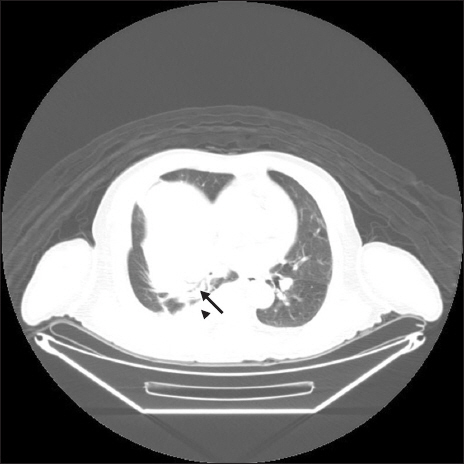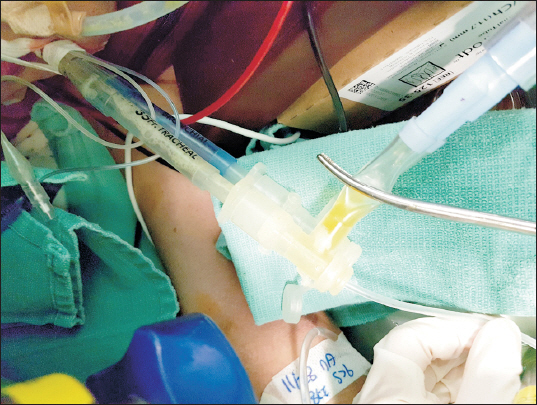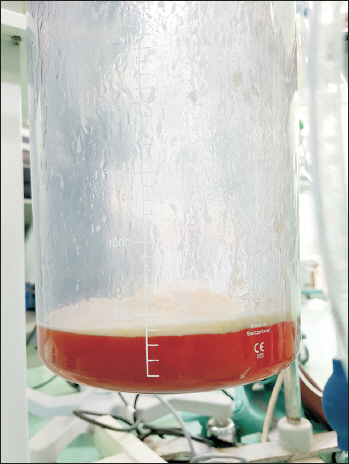Anesth Pain Med.
2019 Oct;14(4):456-459. 10.17085/apm.2019.14.4.456.
Development of alveolar-pleural fistula during hepatectomy: A case report
- Affiliations
-
- 1Department of Anesthesiology and Pain Medicine, Ilsan Paik Hospital, Inje University College of Medicine, Goyang, Korea. jy67925@naver.com
- KMID: 2465345
- DOI: http://doi.org/10.17085/apm.2019.14.4.456
Abstract
- BACKGROUND
An Alveolar-pleural fistula is communication between the alveoli and the pleural space that may result in intractable pneumothorax, severe infection, respiratory failure, physical weakness, and even death. CASE: A 70-year-old male underwent right hepatectomy with a cystic mass of the liver. During the operation, peak airway pressure abruptly increased and a serous fluid was regurgitated through the endotracheal tube. Lung isolation was immediately performed with a double-lumen endotracheal tube. Approximately 1,000 ml of exudate was drained through endotracheal tube. Thoracostomy was performed at right lung. Analysis of fluid from endotracheal tube and pleural effusion consistent with parapneumonic effusion.
CONCLUSIONS
We presented a case of alveolar-pleural fistula caused by pneumonia presenting with massive exudate fluid regurgitated from the endotracheal tube that was managed with bronchial suction, lung isolation, and thoracostomy and improved without surgical repair of the fistula.
Keyword
MeSH Terms
Figure
Reference
-
1. Zheng A, Yang X, Ye X, Huang G, Wei Z, Wang J, et al. Bronchopleural fistula after lung ablation:Experience in two cases and literature review. Indian J Cancer. 2015; 52(Suppl 2):41–6. DOI: 10.4103/0019-509X.172512. PMID: 26728673.2. Tsubakimoto M, Murayama S, Iraha R, Kamiya H, Tsuchiya N, Yamashiro T. Can peripheral bronchopleural fistula demonstrated on computed tomography be treated conservatively?A retrospective analysis. J Comput Assist Tomogr. 2016; 40:86–90. DOI: 10.1097/RCT.0000000000000328. PMID: 26571054. PMCID: PMC4718177.3. Mehta HJ, Malhotra P, Begnaud A, Penley AM, Jantz MA. Treatment of alveolar-pleural fistula with endobronchial application of synthetic hydrogel. Chest. 2015; 147:695–9. DOI: 10.1378/chest.14-0823. PMID: 25057803.4. Weinreb N, Riker D, Beamis J, Lamb C. Ease of use of watanabe spigot for alveolopleural fistulas. J Bronchology Interv Pulmonol. 2009; 16:130–2. DOI: 10.1097/LBR.0b013e31819c100f. PMID: 23168516.5. Rosell A, López-Lisbona R, Cubero N, Obiols C, Rivas F, Dorca J. Endoscopic treatment of persistent alveolar-pleural air leaks with a unidirectional endobronchial valve. Arch Bronconeumol. 2011; 47:371–3. DOI: 10.1016/j.arbres.2010.11.007. PMID: 21420777.6. Wiaterek G, Lee H, Malhotra R, Shepherd W. Bronchoscopic blood patch for treatment of persistent alveolar-pleural fistula. J Bronchology Interv Pulmonol. 2013; 20:171–4. DOI: 10.1097/LBR.0b013e31828f4de0. PMID: 23609256.7. El-Sameed Y, Waness A, Al Shamsi I, Mehta AC. Endobronchial valves in the management of broncho-pleural and alveolopleural fistulae. Lung. 2012; 190:347–51. DOI: 10.1007/s00408-011-9369-1. PMID: 22246554.8. Akulian J, Feller-Kopman D. The past, current and future of diagnosis and management of pleural disease. J Thorac Dis. 2015; 7(Suppl 4):329–38. DOI: 10.3978/j.issn.2072-1439.2015.11.52. PMID: 26807281. PMCID: PMC4700377.9. Dugan KC, Laxmanan B, Murgu S, Hogarth DK. Management of persistent air leaks. Chest. 2017; 152:417–23. DOI: 10.1016/j.chest.2017.02.020. PMID: 28267436. PMCID: PMC6026238.10. Woo JH, Chung RK, Baik HJ, Kim YJ. Hydrothorax with alveolarpleural fistula mimicking re-expansion pulmonary edema during liver transplantation:a case report. Korean J Anesthesiol. 2015; 68:184–7. DOI: 10.4097/kjae.2015.68.2.184. PMID: 25844139. PMCID: PMC4384408.11. Vladov N, Lukanova Ts, Takorov I, Mutafchiyski V, Vasilevski I, Sergeev S, et al. Single centre experience with surgical treatment of hilar cholangiocarcinoma. Chirurgia (Bucur). 2013; 108:299–303. PMID: 23790776.12. Nobili C, Marzano E, Oussoultzoglou E, Rosso E, Addeo P, Bach-ellier P, et al. Multivariate analysis of risk factors for pulmonary complications after hepatic resection. Ann Surg. 2012; 255:540–50. DOI: 10.1097/SLA.0b013e3182485857. PMID: 22330041.13. Yang T, Zhang J, Lu JH, Yang GS, Wu MC, Yu WF. Risk factors influencing postoperative outcomes of major hepatic resection of hepatocellular carcinoma for patients with underlying liver diseases. World J Surg. 2011; 35:2073–82. DOI: 10.1007/s00268-011-1161-0. PMID: 21656309.
- Full Text Links
- Actions
-
Cited
- CITED
-
- Close
- Share
- Similar articles
-
- Hydrothorax with alveolar-pleural fistula mimicking re-expansion pulmonary edema during liver transplantation: a case report
- The Management of Delayed Post-Pneumonectomy Broncho-Pleural Fistula and Esophago-Pleural Fistula
- Pneumocephalus and Pneumorrhachis due to a Subarachnoid Pleural Fistula That Developed after Thoracic Spine Surgery
- Biliary-Colonic Fistula after Hepatectomy Treated by Colonoscopic Clipping
- Pancreaticopleural Fistula: CT Demonstration





